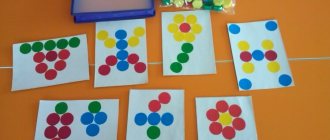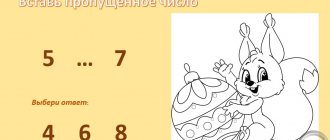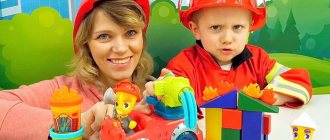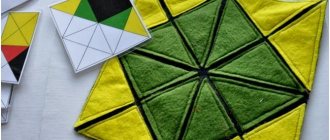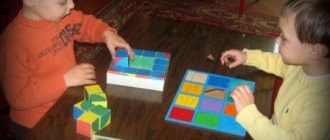Voskobovich's educational games in kindergarten gained popularity at the beginning of the century. Colorful kits with tools and a set of characters for conducting classes were among the first to be mass-produced in a factory version.
The author of the program, Vyacheslav Vladimirovich Voskobovich, made every effort to ensure that teachers understood his idea of the comprehensive development of thinking and creativity in a game with a fairytale edge. And although sets of Voskobovich’s games are sold in almost ready-made form, the author strongly advises introducing your own elements and heroes into the fairy tale, and using foreign objects for visualization. Thus, in the joint creativity of the child and the teacher, the basic skills of logical and creative thinking, reading, and counting will be taught unnoticed and smoothly.
Author
Vyacheslav Vladimirovich Voskobovich, an engineer and physicist from St. Petersburg, was puzzled by the search for educational toys for his own children in the early 90s.
The study of currently existing proposals did not yield anything - the range of domestic teaching material was extremely scarce, and international experience was practically not used.
Acquaintance with the experience of Zaitsev and Nikitins suggested the idea of creating a radically new system of classes, which would be not only useful, but also interesting for children, captivating and developing without forcing them to study. The main idea was to create tools for the comprehensive development of intelligence, logic, talent and personality in a playful way.
Voskobovich’s first games were “Geokont”, “Transparent Square”, “Folds”, “Two-Color Square”. appeared at the very beginning of the 90s. By 1997, the first training manual, “Little Geo, Raven Meter and I, Uncle Slava,” was written, which proposed combining classes with puzzles with a fairy tale twist that immerses the child in the story, giving an additional incentive to action and solving the problem.
In 1999, the author’s program “Fairy Tale Labyrinths of Games” was officially adopted and approved by the Education Committee of St. Petersburg. From now on, Voskobovich presents educational games in preschool educational institutions as an addition to activities that develop intellectual and creative thinking. By the beginning of the century, up to 90% of the city’s kindergartens used the method to one degree or another when organizing work with children.
Currently, the author of the system is the director of Voskobovich's Educational Games. The company and its tutoring center actively cooperate with the Union of Teachers of Russia and conduct training seminars free of charge, including in an online format in accordance with current reality.
Voskobovich's games for preschoolers and their descriptions are offered in sets designed for a certain age and are licensed. Buying an analogue is not encouraged, since the author himself believes that everything is taken into account in the original system. Exact adherence to the author's program, which teachers easily master, gives maximum results, despite the fact that within the framework of the game itself there is always a degree of unpredictable development. The child and the adult become co-creators.
Creation
Another principle of the “Fairy Tale Mazes Game” technology is the early creative development of preschool children. The game creates conditions for creativity and stimulates the development of the child’s creative abilities. An adult can only use this natural need to gradually involve children in more complex and creative forms of play activity.
Methods for implementing the “Fairy Tale Mazes Game” technology
The peculiarities of the technology are such that there is no need to rebuild the work of the institution, break the usual way of life and build a new one. Technology is organically woven into the already familiar rhythm of life and the educational objectives of the implemented program. The only difficulties the teacher faces are stereotypes of his own behavior. The game does not imply domination of the adult over the child in the “adult-child” relationship; it dictates partnerships. Did the teacher used to be the child’s partner in our kindergartens? It wasn't, and for many reasons. These are groups that are too “large” and these are also pedagogical postulates that had to be followed.
In preschool institutions using our technology, the child is surrounded by a relaxed, cheerful, intellectual and creative atmosphere that does not evoke negative emotions. Like lace from thin threads, it is woven from a feeling of external security, when the child knows that his manifestations will not receive a negative assessment from adults, and a feeling of internal relaxation and freedom due to the support of adults for his creative endeavors.
Methodology
Each of Voskobovich's games has clearly defined pedagogical tasks and goals. But during the lesson, not only the child himself, but also the teacher disconnects from it. The kid helps decorate the boat with flags, arranges numbers from the album into the train cars, builds a magical web of strings, while gaining the most useful skills and knowledge for his age, from the development of fine motor skills, if we are talking about a 2-3 year old child, to solving equations. In most cases, the characters and environment are presented in the form of a construction set or mosaic. It will depend on the child himself how they will look in the process - this develops creative thinking, visual memory and a sense of taste.
General objectives of the development program:
- developing interest in the world around us, attention, memory, reducing attention deficit ratio, establishing trusting relationships with adults and playmates;
- developing research interest, creative thinking, and the ability to find non-standard solutions to situations;
- training of creative thinking, logical flexibility;
- psycho-emotional development, increased stress resistance, perseverance;
- practice of developing speaking, reading, and counting skills.
The plots and environments proposed by Voskobovich are only a support for conducting such classes. This is a multifunctional environment with secrets that the teacher himself can unexpectedly discover if he is sincerely interested in the process.
How are classes conducted using the Voskobovich method?
Before starting classes, be sure to read the methodological recommendations and instructions for the Voskobovich game that you bought for your baby. It is very important not to force your child to complete certain tasks in the game. The child must determine the pace and level of load himself, independently switching from one task to another.
Since Voskobovich’s games assume that the child will sit in one place for some time, the author of the technique advises that at first, classes should last about 10 minutes. After a short break, when the child runs around a little, you can return to completing tasks.
Voskobovich's fairytale method is built on trusting and friendly relationships between the child and parents, when adults and children are partners and support and help each other in everything. Therefore, if your child doesn’t succeed in something the first time, there is no need to criticize him. Praise your child more often, and rejoice at his every victory (even if it is insignificant).
In the process of completing tasks, children almost all the time work only with their hands and interact very little with the environment. In order for the child to develop not only memory, logic, thinking, motor skills, etc., but also speech, Vyacheslav Vadimovich Voskobovich recommends asking the child to comment on all his actions or retell the plot of a fairy tale. Ask your child as many questions as possible about what fairy-tale task he is performing now, and what options for completing it he has already come up with.
Fairy tales
The main environment into which the teacher immerses the child is the purple forest and characters that change with the stages of growing up. Most loved by children:
- Lopushok is the first instructor in handling the proposed didactic materials;
- All is the hero of a transparent square, introducing geometric shapes, colors, letters;
- Kitten Timoshka from the Miracle Crosses set teaches children to see the difference in colors and shapes, compare and look for commonalities;
- Krutik Po - responsible for geometric shapes and spatial thinking.
The variety of heroes is huge - Lord Lucic, Crab Krabych from Miracle Island, Dwarves and Dolka. All of them are inhabitants of that same Violet Forest - a spatial-objective environment, divided into areas with their own specifics.
Many roles are spelled out. Dolka is a character who should introduce the child in a playful way to the concepts of parts and the whole, and smoothly lead to the study of fractions. In this case, the fractions will be presented on the same ready-made Flower figurine, from which you can take out and add petals. But even if during the game her role changes or the character leaves her clearing and appears somewhere in the area of the Mysterious Island or goes into space, which was not originally in the Violet Forest, the fairy tale will only benefit from this.
Technically, the characters are made of thick laminated cardboard or plywood and are equipped with at least two types of fastening - a magnet and Velcro. The latter allows you to mount the figure on the main display of the Carpet or any other textile surface, if the development of the scenario requires it. A magnet connects the part to metal displays or standard educational nurseries, which are equipped with preschool educational institutions. When purchasing a set for your own child, the characters can be purchased separately as they grow older.
The ship "Plush-Plush"
While playing with a colorful boat with sails that can be put on wooden yards, tactile sensations and fine motor skills are developed. The numbers from one to five are printed on the base of the toy. You need to attach a certain number of flags to the mast, having previously sorted them by size and color. While playing with the boat, the child will meet sailor Frog and Captain Goose, who will tell about their exciting adventures. This multifunctional game, which is used as part of development according to the Voskobovich method, introduces the child to different colors and develops initial mathematical skills. In addition, the process develops skills in sorting objects, taking into account their color and quantity.
Preparation for classes
The technique is considered to be as comfortable and simple as possible for teachers to master. The leader of the process must himself study the material and the proposed characters, learn their main roles, wandering from one game to another. Then he introduces them to the children. You will also have to familiarize the child with the proposed tool - the rules for handling it, safety precautions. All parts and elements in factory kits are made taking into account the recommended age.
There are no ready-made scripts; you don’t have to read prepared stories. The teacher himself decides in what form to present the planned exercise, based on the roles of the characters. The child himself becomes an important co-author. And even if during the game the storyline is completely transformed, there is no problem.
During the lesson, the teacher must:
- constantly assess the level of difficulty, reduce or increase it relative to the recommended age level, depending on the child’s reaction;
- push and stimulate to solve a problem, without directly leading to a solution and without depriving the pleasure of emerging victorious from the battle;
- together with the child, come up with new rules and story lines, not succumbing to the desire to simplify to the basic;
- look for new forms and tools for developing the plot not according to the script;
- control the process and stop the lesson if the baby’s mood has deteriorated critically and interferes with further exercises.
The main task of the teacher is to maintain a trusting atmosphere between him and the child. From the outside it should seem like two people are solving the problem.
"Math baskets"
“Math baskets” will help strengthen counting skills, explain the composition of numbers, teach how to perform simple mathematical operations and compare numbers. In addition, fine motor skills develop while completing tasks. During the game, the child helps fairy-tale characters put mushrooms into baskets. You need to find out who collected more and who collected less, how many mushrooms need to be put in so that the basket is full, and so on. The author’s methodological manual describes more than ten different games with “Math Baskets”.
Advantages
Teachers using the methodology note two main advantages - an integrated approach to the development and education of children and the completeness of the proposed tools.
The game includes a developing subject environment for action, elements for manipulation, and complete instructions for an employee of an educational institution. This also helps parents who do not have a pedagogical education - they can get acquainted with the system within a couple of hours (study the manual or get acquainted with the recommendations for a specific game on the manufacturer’s website for free) and conduct a lesson with the child on their own.
The author himself insists that the merits of his system are the quality of children’s development:
- the emergence of the skill to receive and analyze information;
- development of creative thinking, reading and counting skills;
- the emergence of a model of behavior in society, empathy and compassion;
- formation of perseverance, desire to achieve goals, healthy persistence.
Moreover, everything happens in a playful, imperceptible form. The child simply plays, perceiving the didactic material as just another form of entertainment.
The quality of factory toys should also be noted. Materials approved by sanitary control authorities are used for production. When used in educational institutions, visual aids do not lose their appearance for a long time, even with regular sanitization. The content-rich environment is also transformable and completely safe.
Teremki Voskobovich
A unique instructional model is used to prepare for early reading. Judging by the reviews, this is a very interesting technique. "Teremki" enriches vocabulary, develops fine motor skills, creativity and mental processes. In a playful way, the child learns to connect letters into syllables and transform syllables into words. The manual includes twelve multi-colored towers on which sounds are written. Each cube is equipped with an arch or window for vowels. To connect letters into a syllable, you need to put a certain chest in the corresponding house and sing the formed syllable. This manual, which is used as part of training using the Voskobovich method, is accompanied by detailed instructions describing the games.
Recommendations by age
Games and manuals are accompanied by descriptions indicating the recommended age. In practice, the same item can be used for an entire period of 2 to 7 years.
If a spider with a web of rubber bands teaches a two-year-old child the concept of colors and more or less, tones on the same basis, when preparing for school, the child can collect figures according to the abbreviation conceived by the teacher (route map) or solve the problem of inscribing an isosceles triangle into a square.
It all depends on the fairy tale proposed by the presenter. Even when using the same instrument in a group, you can change the difficulty of the lessons, going through the levels like in a computer game. The desire to reach the end or score extra points will be an additional incentive.
Carpet "Larchik"
The carpet grapher occupies a special place in Voskobovich’s methodology - this is a unique author’s manual that is free from many of the shortcomings of the school board. The carpet adheres well to the contact tape, which allows you to securely fasten visual material, and original elements (pockets, ropes, circles, clips) ensure dynamic learning. The manual provides scope for the activities of teachers and is suitable for group and individual lessons. The tasks are grouped by age. For each age, the methodological manual provides various tasks for the development of memory, attention, thinking, creativity, there are tasks in mathematics, teaching literacy and developing speech.
The carpet includes the playing field itself made of carpet (1.2 m x 1.2 m), on which a grid is applied. The set includes special clips so that the rug can not only be placed on the floor, but also hung on the wall. There are five multi-colored ropes made from contact tape, twenty-five Velcro, ten blank multi-colored cards, cards with letters and numbers, ten cardboard cards with funny letters and the same number with interesting animal numbers.
Games
The author suggests considering your games as a set of activities from 2 to 7 years old. But in practice, they can be used separately - most puzzles are independent and do not require additional investment. Buying a set is interesting only because of the variety of activities and the expanded possibilities of using each element.
"Purple Forest"
The main environment for conducting classes using the Voskobovich method. The carpet base makes it easy to move and place additional elements around the space, to which Velcro is attached. The basic equipment is designed to familiarize the child with the environment, study the seasons, and natural phenomena.
Set of basic parts corresponding to:
- trees and colorful leaves;
- clouds, sun and moon;
- the most popular animals of the forest;
- design for lake and forest areas.
On a carpet base, the teacher can attach both ready-made factory objects and characters, drawing the child into the game, and those made independently. You can involve your child in the process of inventing new stories and personalities. It is enough to attach Velcro to the craft so that the craft becomes an inhabitant of the purple forest.
As they grow older, the characters can change, and the space can turn from a forest into a preschooler’s room. Manufacturers offer to buy not only cardboard and wooden figurines for the Violet Forest, but also watches, technical devices and complex puzzles. The base remains the same. Recommended age: 2-7 years.
"Boat Plop-Plop"
Plastic boat with five multi-colored masts. The masts are perforated and consist of segments that are put on according to the pyramid principle. The game invites you to thread multi-colored strings through the holes - to study colors, shapes, and sizes in the game.
Attached to the independent kit is a training manual that contains the most popular author's puzzle tasks for the little ones. At the same time, parents can come up with an unlimited number of their own tasks or suggest that the child come up with a task for the teacher. Recommended age: from one year.
"Geocont"
Voskobovich's geokont is a plywood base with lacing supports attached to it. The supports are labeled, which allows you to give tasks to reproduce not only a specific drawing, but also a route along a kind of map with marked points. Colored elastic bands are included.
Based on Geokont Voskobovich, you can learn letters and numbers, teach spatial thinking (display objects from different sides and in mirrors), conduct creative activities on drawing with non-traditional materials. The author proposed several geocont options designed for different age groups. Age from 3 to 7 years.
"Voskobovich Square"
Eternal origami is a puzzle made from laminated cardboard. The child will have to assemble shapes and objects from the red and green triangles applied to the base.
The game develops thinking, logic, and fine motor skills. A manual with assembly options is included in the kit. Recommended age: 2 to 7 years.
"Math baskets"
A number of activities can be carried out based on the set with numbers. Your helpers will be the Numbers from the Violet Forest, who collect mushroom numbers after the rain.
The child learns numbers and order, trains mental calculation and observation skills in a playful way. Additional elements of the Chest kit can be purchased separately, diversifying the process.
"Foldings"
A series of cards with short nursery rhymes, using which a child learns to read by syllables (words). In this game, the author modernized the popular method of teaching early reading by N. Zaitsev. The game is designed for children from 3 years old.
"Voskobovich Square"
The “transformable square” consists of thirty-two multi-colored triangles, which are applied to a fabric base and located at a certain distance from each other. The game is designed for ages from two to five years (two-color square), and for older children there is a four-color square. The square can be transformed to create different shapes. You can assemble according to the proposed schemes or come up with your own. There are more than a hundred options.
The educational game according to Voskobovich’s method is accompanied by a fascinating fairy tale “The Mystery of the Raven Meter” and teaching aids. Fairy-tale characters will help your child solve problems: dad Rectangle, grandfather Quadrangle, baby Square and others. The game develops abstract thinking and the ability to navigate in space, instills modeling skills, develops perseverance, memory and attention, and creativity.
Game aids
Tools for games from Voskobovich can be purchased separately or in sets. In the second case, there will be significant growth and diversity based on a single sensory environment. At the same time, the author himself recommends not dwelling on ready-made options, introducing your own characters, setting new tasks with the understanding that the child has outgrown the recommended ones.
All models and elements of didactic material are designed for multifunctional use. Fasteners, magnets, and Velcro allow the same characters to be transferred from one game to another, placed on a canvas or magnetic board, preventing the child from getting used to it and getting tired of the monotony.
With the creation of your own environment and technical additions, the situation is more complicated. Since 2013, the development center has hired professional artists who control not only the compliance of the color scheme of the manuals with the assigned tasks, but also the quality of product design.
Voskobovich's self-created games for preschoolers with their own hands are often inferior in quality and visual appeal to the eyes of factory-made kits. Children who are demanding about wrappers are not always ready to accept a replacement. But the final decision remains with the teacher and parent. Even partial application of Voskobovich’s methods in the learning process has a positive effect on the result and dynamics of work.
With the abundance of educational games nowadays, Voskobovich’s technique has not lost its relevance. Curricula are actively used by preschool teachers and can be implemented by parents themselves. The simplicity and fun of the system allows you to do this. The company's team, under the leadership of its founder, periodically updates the range of benefits and offers new forms that take into account the interests of modern children.
"Magic Gonziki"
A fun game develops acting talent, fine motor skills, attention and memory, and can also help in remembering the names of all fingers. This is also good psychological help: a child can put on a Gonzik and answer an adult’s questions not on his own behalf, but on behalf of a fairy-tale character, talk about the problems of the Gonzik (in fact, the problems of the child himself). There are a lot of games with fairy-tale characters, and Voskobovich’s method is good. Gonziki will help you learn rhymes, memorize and repeat actions, and develop fine motor skills. The game is suitable for children from two to seven years old.

